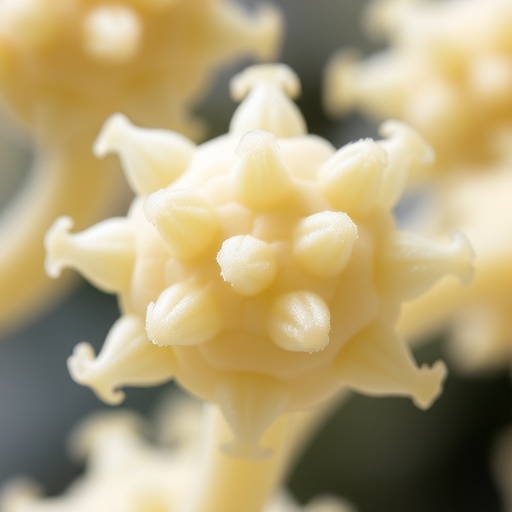In a groundbreaking study that addresses a pressing issue in antibiotic resistance and environmental microbiology, researchers have isolated a strain of bacterium from the genus Sphingomonas capable of degrading the antibiotic tiamulin, which is classified as a pleuromutilin antibiotic. This discovery highlights the potential of certain microbial strains to mitigate the impact of antibiotics that are increasingly scrutinized due to their role in antibiotic resistance and environmental persistence.
Tiamulin is widely used in veterinary medicine, particularly in the treatment of swine and poultry. Its effectiveness in controlling bacterial infections is undisputed, yet the residual presence of such antibiotics in soil and water systems poses a long-term risk to both environmental and human health. The contamination not only harms non-target microbial communities but also fosters the development of antibiotic-resistant bacteria, an issue that has garnered global attention in recent years. The need to find biological solutions to this problem is paramount, making the findings of this study both timely and critical.
The research team employed a series of innovative methodologies to characterize the isolated Sphingomonas strain. With an emphasis on in vitro analysis, they meticulously documented the antibiotic degradation capabilities of the bacterium. By using advanced comparative genomics, transcriptomics, and metabolomics, the scientists were able to unravel the complex biochemical pathways the bacterium utilizes to break down tiamulin. Such a multi-omics approach not only offers insights into the degradation mechanisms but also provides a framework for understanding how environmental factors influence these microbial processes.
When examining antibiotic transformation, it is vital to note the specific enzymes involved. The research identified several key enzymes that play a crucial role in the breakdown of tiamulin. The researchers conducted assays to quantify the enzyme activity under various environmental conditions, shedding light on how factors such as pH, temperature, and nutrient availability impact the degradation rate. Remarkably, the strains showed significant resilience and adaptability, indicating their potential for use in bioremediation applications.
Beyond enzyme characterization, the transcriptomic analyses provided substantial insights into the gene expression profile of the Sphingomonas strain during different growth phases and under varying environmental stimuli. The results unveiled a set of upregulated genes that correspond to the metabolic pathways engaged in the degradation of tiamulin, illustrating the bacterium’s capacity to sense and respond to the presence of the antibiotic in its environment. These findings underscore the adaptive strategies employed by such microbes to thrive in antibiotic-contaminated habitats.
Moreover, metabolomic profiling elucidated the by-products of the tiamulin degradation process. Identifying these metabolites is crucial for understanding the transformation pathways fully. The various metabolic products generated from the degradation process not only reveal the efficiency and effectiveness of the Sphingomonas strain but also allow scientists to evaluate the safety of these by-products in the environment. The study raises important questions regarding the environmental implications of these metabolites and their potential ecological impacts.
The implications of this research extend far beyond the laboratory. Discovering a microorganism capable of degrading pharmaceutical contaminants can significantly contribute to bioremediation efforts aimed at addressing the fallout from antibiotic misuse. The potential application of this strain in bioremediation processes could pave the way for a more sustainable approach to managing residual antibiotics in agricultural runoff and wastewater systems, thereby protecting human health and preserving biodiversity.
In a world increasingly grappling with the repercussions of antibiotic resistance, the significance of microbial degradation pathways cannot be overstated. This study emphasizes the importance of harnessing the natural abilities of microorganisms to counteract pharmaceutical pollution. By tapping into the metabolic capabilities of Sphingomonas, researchers can develop targeted strategies to combat the environmental persistence of antibiotics and the associated risks of resistance development.
Furthermore, this research sets a precedent for future studies aimed at isolating and characterizing additional microbial strains with similar degradation capabilities, further expanding our arsenal against antibiotic pollution. Understanding the ecological roles played by these microorganisms can lead to enhanced biomanagement strategies that can mitigate the negative impacts of pharmaceutical contaminants present in various ecosystems.
The future of antibiotic degradation through microbial pathways is not only promising but necessary. With the rise of antibiotic-resistant infections, innovative approaches like this are vital for ensuring effective treatments for bacterial infections in both humans and animals. As we strive to develop more sustainable agricultural and veterinary practices, incorporating bioremediation strategies using efficient microbial strains appears to be a feasible and scientifically robust path forward.
In conclusion, the isolation of the Sphingomonas strain that can degrade tiamulin represents a significant advancement in the field of environmental microbiology and antibiotic degradation. As our understanding of these microbial processes deepens, the potential applications for bioremediation continue to expand, holding promise for a more sustainable approach to addressing the pressing issue of antibiotic pollution. It is imperative that future research builds upon these findings, exploring the mechanisms at play while remaining vigilant to the impacts of metabolic by-products on ecosystem health.
The fight against antibiotic resistance and environmental degradation is far from over, but the work being done in labs across the globe is a step toward a more resilient microbial and ecological future. This study is a testament to the power of science in not only unveiling novel microbial capabilities but also in developing actionable solutions to one of modern society’s most significant challenges.
Subject of Research: Isolation and characterization of a Sphingomonas strain responsible for tiamulin degradation.
Article Title: Isolation of a Sphingomonas strain able to degrade the pleuromutilin antibiotic tiamulin: in vitro characterization of the antibiotic transformation capacity and pathway elucidation via comparative genomics, transcriptomics, and metabolomics.
Article References:
Perruchon, C., Tagkalidou, N., Kalogiouri, N. et al. Isolation of a Sphingomonas strain able to degrade the pleuromutilin antibiotic tiamulin: in vitro characterization of the antibiotic transformation capacity and pathway elucidation via comparative genomics, transcriptomics, and metabolomics.
Environ Sci Pollut Res (2025). https://doi.org/10.1007/s11356-025-36996-y
Image Credits: AI Generated
DOI:
Keywords: Sphingomonas, tiamulin, antibiotic degradation, bioremediation, antibiotic resistance, environmental microbiology.




